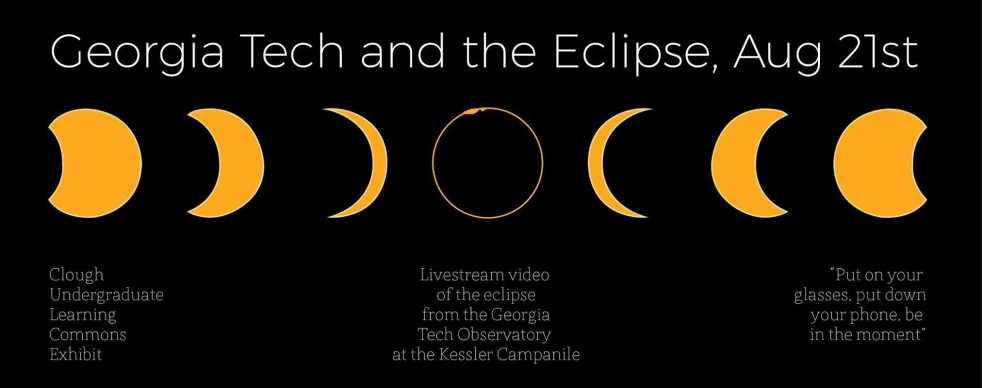during the first day of Fall classes, the sun over Tech and the city of Atlanta will begin to dim at 1:05 p.m. EDT. Over the course of an hour and a half, as the moon swoops in from the upper right to cut between Atlanta and the sun, the sun will morph into a crescent that will grow slimmer by the minute.
The sky will darken until the eclipse reaches its climax, when, at 2:36 p.m., 97 percent of the sun’s visible area will be blocked by the moon; close to a total eclipse, but not quite. That’s because Atlanta lies outside of the path of the moon’s umbra, the part of the moon’s shadow where the sun is completely blocked.
Instead, lying in the partial shadow of the penumbra, viewers at Tech will see a partial eclipse in which the sun will dim significantly but not be completely blocked. After reaching its darkest point at 2:36 p.m., the moon will slowly swing out of the sun’s way, restoring the interrupted afternoon sunshine at 4:01 p.m.
During the time of the eclipse, from 1 to 4 p.m., Tech will hold Celebrate Eclipse 2017 events at the Campanile, including livestream of the eclipse from the Georgia Tech Observatory, astronomy-themed music and snacks, hands-on activities, and more.
While looking at the sun during the partial eclipse, one should use appropriate eyewear that meets the ISO 12312-2 standard for safe sun-gazing—normal sunglasses won’t do the job. Tech will distribute solar-eclipse glasses throughout campus at noon before the eclipse.
The solar rays that are not blocked during the partial eclipse can still cause significant thermal and photochemical damage to your retinas.
The last eclipse to pass through the entire contiguous United States did so on June 8, 1918, and therefore this eclipse, already rare, will be a once-in-a-lifetime event.
Those who want to catch a total eclipse in Georgia have drive up to the northeast corner of the state by early afternoon on the day of the eclipse. The largest city in Georgia to experience the total eclipse is Clayton, Georgia, where total eclipse begins at 2:35 p.m. and ends at 2:38 p.m., lasting merely six minutes as the umbra sweeps over at a speed of nearly 1500 miles per hour.
It’s not all fun and games though: the eclipse will cause a significant strain on the U.S. electrical grid as solar panels’ output drop and rise with the passage of the moon—a problem most acute in California, whose grid is powered 10 percent by solar energy, according to the U.S. Energy Information Administration. To compensate, gas and power plants in California will have to ramp up output by over 6,000 megawatts over the course of an hour and a half, enough to power Los Angeles, according to a Quartz article published in May.
For those not in United States at the time of the eclipse, NASA will provide a livestream of the total eclipse from locations across the country, available on their website. You can also learn more about the eclipse by visiting Tech’s College of Sciences website.
